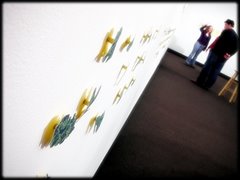 Janet Cardiff
Janet CardiffA Canadian installation artist.
Her audio project for Whitechapel Gallery in London
was an interesting work for me.
This work was audio-based, called "audio walk."
I have never heard that this kind of audio art work exists.
As we see from the picture on the left side, in her gallery at London there was no visible image around the hall, but long chairs and bunch of standing speakers on the same height as the audience.
What you are asked to do is just to listen to the audio and follow where Cardiff is taking us to.
The foreground of her audio would be the sound of footsteps and her voice.
They were the loudest, clearest, and the least reverberating sound. Her whispering voice keeps her flat tone, but these two sounds lead the whole audio walk.
The sound of dogs barking, accordion, helicopter passing by and guy speaking to her would belong to the middle ground. And the background sound would be sound of see waves, birds singing, water, and stepping on dried leaves. These sounds have less volume, compared to the foreground and they do not demand what to do to audience, which means it has less importance than the foreground sounds. What the audience needs to concentrate is not the sound of waves, or birds but, the voice of the woman who is speaking to the audience who are supposed to imagine themselves following her.
I was surprised by realisingthe demanding force in her work.
Unconsciously, as we listen to her work, we can find ourselves doing what her voice is
telling us to do. That helps to prove the possibility that artists and audience can interact together. Art becomes more interactive.
Her flat tone voice keeps telling us what we are about to do, like-
"Let's walk to the garden...
try walk to the sound of my footsteps so that
we can stay together... I want to bring you here...
keep walking... Let's continue...
stop... listen... close your eyes, trust me... "
But also, I think showing no visible image but only letting people to listen to her audio
has a strong positive influence, which makes the audience enable to choose what they want to
see, not the artist shows. Although she is a stranger for us, but by listening to her voice and her private detail stories, such as about her grandmother, things that she hears, smells, sees on the path as she walks and her kiss near the sea shore, we feel closer to the artist.

No comments:
Post a Comment